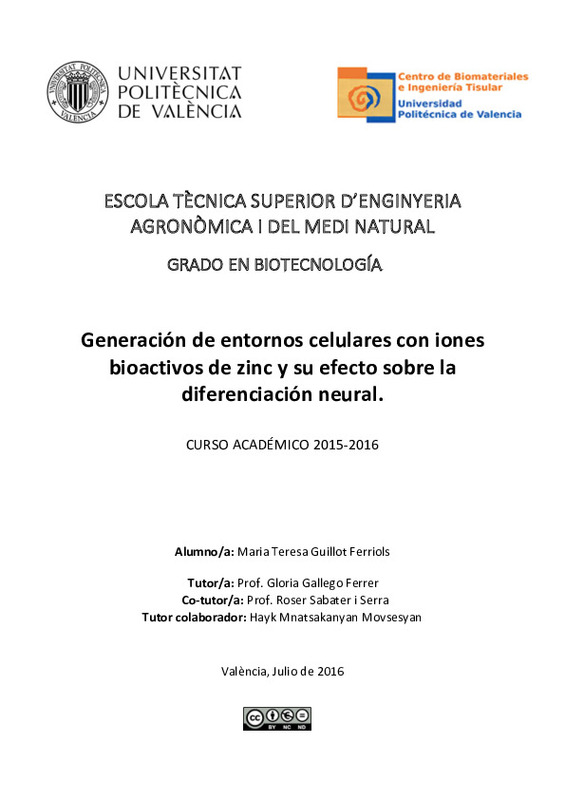|
Resumen:
|
[ES] El zinc es uno de los metales de transición más abundantes en el organismo. Es un elemento esencial para el crecimiento y el desarrollo y está ampliamente implicado en la dinámica celular, debido a su presencia en la ...[+]
[ES] El zinc es uno de los metales de transición más abundantes en el organismo. Es un elemento esencial para el crecimiento y el desarrollo y está ampliamente implicado en la dinámica celular, debido a su presencia en la estructura tanto de enzimas como de factores de transcripción. La importancia de este ion en el sistema nervioso central es considerable, existiendo evidencias directas de su función señalizadora, actuando como neurotransmisor.
El presente proyecto se basa en la hipótesis de que entornos celulares con concentraciones no citotóxicas de zinc liberadas controladamente pueden tener un efecto positivo sobre la diferenciación neural de precursores neurales. Para evaluar la hipótesis, en primer lugar, se determinará la cantidad de zinc máxima permitida en el cultivo celular no-citotóxica. Posteriormente se evaluará el efecto del suministro directo en el medio de cultivo de esas concentraciones no-citotóxicas de zinc sobre la diferenciación neural. Para el estudio se partirá de precursores neurales generados a partir de células madre embrionarias de ratón y se determinará el porcentaje de diferenciación hacia los tipos celulares neuronas y glía. Previamente al cultivo de diferenciación, se optimizará el protocolo de obtención de precursores neurales mediante la suplementación del medio con ácido retinoico.
Con objeto de crear entornos celulares con consistencia mecánica y liberación controlada de iones zinc se preparará soportes biodegradables de ácido poliláctico (PLA) cargados con iones zinc a partir de sales de ZnCl2, dispersados en la matriz por emulsión. Se evaluará la dinámica de liberación de zinc desde estos entornos, persiguiendo en todo momento que no se supere la cantidad citotóxica. Estos substratos serán propuestos como soportes generadores de entornos biomiméticos con aporte de iones zinc para la diferenciación neural, de cara a una futura aplicación de ingeniería tisular.
[-]
[EN] Zinc is essential in the organism. It is a structural element of a large number of enzymes and transcription
factors, it is able to act as a second messenger and plays and important role in the central ...[+]
[EN] Zinc is essential in the organism. It is a structural element of a large number of enzymes and transcription
factors, it is able to act as a second messenger and plays and important role in the central nervous
system, acting as a neurotransmitter.
In the present work we have studied the effect of this divalent ion on the differentiation of neural
precursors obtained from mice embryonic stem cells. We have tested three protocols to obtain neural
precursors, based on the supplementation of the culture medium with retinoic acid. The addition of 0,5
µM of retinoic acid in the medium during 8 days has proved to be the optimum protocol. To demonstrate
zinc effect on this neural precursors, we have proved that concentrations of 40 µM of Zn 2+ or higher are
toxic for this cellular type; thus we have employed concentrations of 10 and 20 µM to evaluate its effect
in neural differentiation. There are no significant statistic differences in the number of GFAP and βIIItubulin
positive cells between the control condition, which only contains neural differentiation medium,
and medium supplemented with 10 µM of Zn2+. Nevertheless, 20 µM of zinc concentration reduces the
number of GFAP positive cells, increasing the ratio between GFAP and βIII-tubulin positive cells.
In parallel with the previous study, we have prepared biodegradable 2D substrates based on poly lactic
acid (PLLA) for the controlled release of zinc ions. These substrates have been obtained by solvent casting
method, by an emulsion of PLLA/chloroform and ZnCl2/miliQ water. The films obtained are not
homogeneous due to the instability of the emulsion. This phenomenon hinders the prediction of the
materials as a release vehicle. It will be necessary the use of alternative techniques for their preparation.
[-]
|










